Section PC.0 – Practice Problems
Section PC.0 – Practice Problems
1. Use the roster method to list the elements of the set: The letters of the word “Mississippi”.
2. Use the roster method to list out the elements of the set “Months of the year".
3. Suppose the universal set is U = {1, 2, 3, … , 8, 9, 10}. If [latex]A[/latex] = {5, 6, 8}, find [latex]\bar{A}[/latex].
4. Suppose the universal set is U = {red, orange, yellow, green, blue, purple}. If [latex]A[/latex] = {red, green, blue}, find [latex]\bar{A}[/latex].
5. Suppose the universal set U is all even numbers from 2 to 20. If [latex]A[/latex] = {4, 6, 10, 16, 18, 20}, find [latex]\bar{A}[/latex].
6. Let U = {1, 2, 3, … , 18, 19, 20} be the universal set. Consider the sets:
[latex]A[/latex] = {2, 3, 5, 7, 10, 11, 12, 13, 14, 16, 17, 19}
[latex]B[/latex] = {5, 10, 13, 14, 16, 19, 20}
Find the following:
a. [latex]A~\cup~B[/latex]
b. [latex]A~\cap~B[/latex]
c. [latex]\bar{A}~\cap~B[/latex]
7. Let U = {1, 2, 3, … , 18, 19, 20} be the universal set. Consider the sets:
[latex]A[/latex] = {6, 11, 12, 14, 16, 17, 18}
[latex]B[/latex] = {1, 4, 5, 8, 11, 12, 15, 16}
Find the following:
a. [latex]A~\cup~B[/latex]
b. [latex]A~\cap~B[/latex]
c. [latex]A~\cap~\overline{B}[/latex]
8. Let U = {1, 2, 3, ... , 18, 19, 20} be the universal set. Consider the sets:
[latex]A[/latex] = {1, 2, 3, 4, 6, 8, 9, 11, 12, 14, 15, 18}
[latex]B[/latex] = {5, 9, 12, 14, 17, 19, 20}
Find the following:
a. [latex]A~\cup~B[/latex]
b. [latex]A~\cap~B[/latex]
c. [latex]\bar{A}~\cap~B[/latex]
9. Let U = {1, 2, 3, … , 8, 9, 10} be the universal set. Consider the sets:
[latex]A[/latex] = {3, 5, 8, 10}
[latex]B[/latex] = {1, 3, 4, 7, 8, 9, 10}
[latex]C[/latex] = {2, 5, 6}
Find the following:
a. [latex]A~\cup~C[/latex]
b. [latex]B~\cap~C[/latex]
c. [latex]A~\cap~\overline{B}[/latex]
d. [latex]\overline{(A~\cup~C)}[/latex]
10. Let D = {b, a, c, k}, E = {t, a, s, k}, F = {b, a, t, h}, and U = set of letters in the alphabet. Using these sets, find the following:
a. [latex]\bar{D}~\cap~E[/latex]
b. [latex]\bar{F}~\cap~D[/latex]
11. Create a Venn diagram to illustrate each of the following:
a. [latex]\bar{C}[/latex]
b. [latex]A~\cup~B[/latex]
c. [latex]A~\cap~B[/latex]
d. [latex]A~\cup~\overline{B}[/latex]
12. Use the Venn diagram to write each of the sets below in roster form.
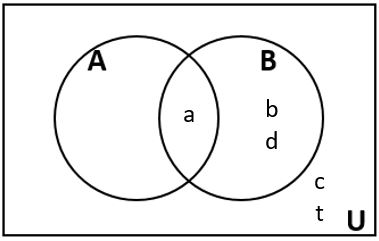
a. [latex]\bar{A}~\cap~B[/latex]
b. [latex]\overline{B}~\cup~A[/latex]
13. Let A = {1, 2, 3, 4, 5} B = {1, 3, 5} C = {4, 6}
Find the following:
a. The cardinality of [latex]A[/latex]
b. The cardinality of [latex]B[/latex]
c. The cardinality of [latex]A~\cup~C[/latex]
d. The cardinality of [latex]A~\cap~C[/latex]
14. Let A = {1, 5, 9} B = {1, 2, 3, 4, 5, 6, 8} C = {2, 4, 5, 8, 9}
Find the following:
a. [latex]n(A)[/latex]
b. [latex]n(B)[/latex]
c. [latex]n(C)[/latex]
d. [latex]n(B~\cap~C)[/latex]
e. [latex]n(A~\cup~C)[/latex]
15. Consider the Venn diagram below.
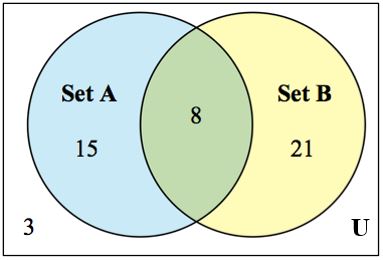
Find the following:
a. [latex]n(A)[/latex]
b. [latex]n(\bar{A})[/latex]
c. [latex]n(B)[/latex]
d. [latex]n(\overline{B})[/latex]
e. [latex]n(A~\cap~B)[/latex]
f. [latex]n(A~\cup~B)[/latex]
g. [latex]n(\bar{A}~\cap~B)[/latex]
16. Consider the Venn diagram below.
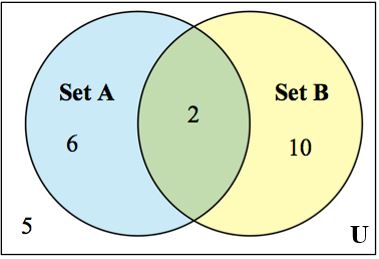
Find the following:
a. [latex]n(A)[/latex]
b. [latex]n(\bar{A})[/latex]
c. [latex]n(B)[/latex]
d. [latex]n(\overline{B})[/latex]
e. [latex]n(A~\cap~B)[/latex]
f. [latex]n(A~\cup~B)[/latex]
g. [latex]n(\bar{A}~\cap~\overline{B})[/latex]
17. Consider the Venn diagram below.
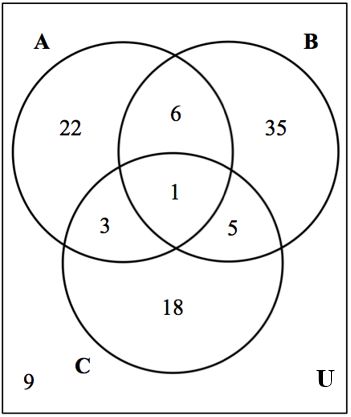
Find the following:
a. [latex]n(A)[/latex]
b. [latex]n(C)[/latex]
c. [latex]n(\overline{B})[/latex]
d. [latex]n(A~\cap~C)[/latex]
e. [latex]n(B~\cup~C)[/latex]
f. [latex]n((B~\cap~C)~\cup~A)[/latex]
18. The following Venn diagram shows students in various college courses.
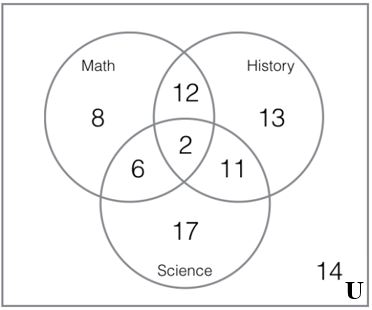
Find the following:
a. How many students are taking Math?
b. How many students are taking Math and Science?
c. How many students are taking History and Science, but not Math?
d. How many students are taking exactly two of these classes?
19. How many students are taking exactly two of these classes.
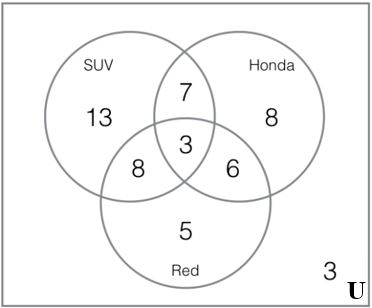
Find the following:
a. How many Hondas are in the parking lot?
b. How many red SUVs are in the parking lot?
c. How many of the Red cars in the parking lot are not Hondas?
20. The following Venn diagram shows people at a party.
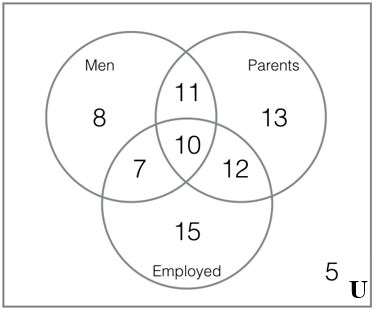
Find the following:
a. How many people at the party are employed?
b. How many people at the party are mothers?
c. How many people at the party are working fathers?
d. How many people at the party are not parents?

